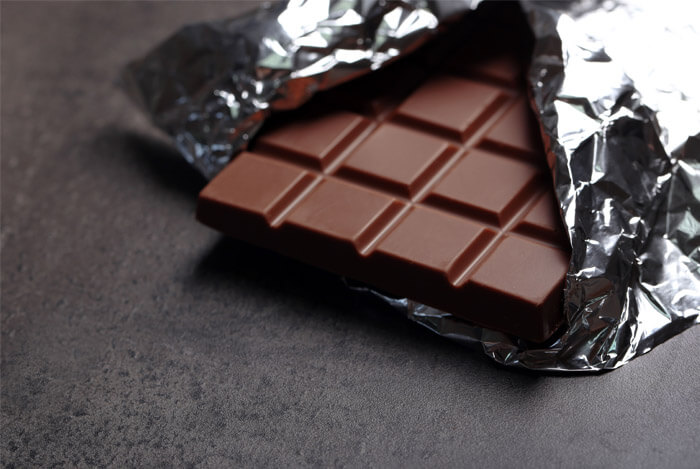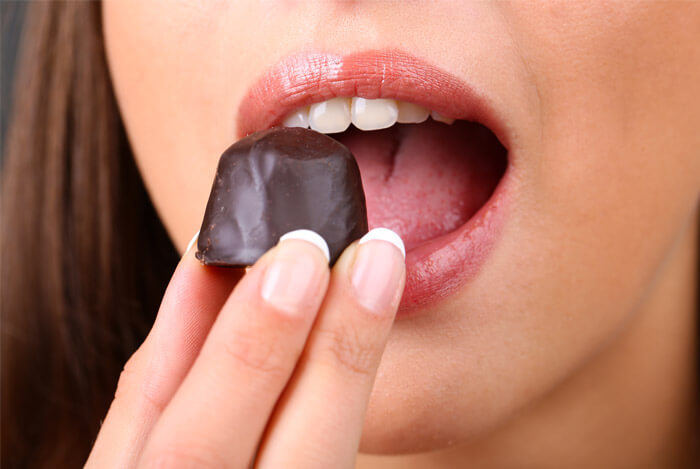Seriously, is there anything better than chocolate? It satisfies your sweet cravings, it’s been touted as having super healthy benefits, and it makes you feel happy.
Even though I’m a die-hard supporter of fruits and veggies, they sure have a lot to compete with when it comes to chocolate.
And I know I’m not the only one who feels this way; according to one estimate, Americans will eat “$18.27 billion worth” of chocolate by the end of 2015.
While we’re lucky enough to have our pick of chocolate out there, chocolate was once considered “a highly-prized luxury item among Mayan and Aztec upper class elites”. Aztec rulers considered cacao beans as valuable as gold. They even used cacao beans to pay taxes!
If only that were the case now, right?
So how did this one bean become such a prized commodity all over the world?
Well, because of what it does to us and how it makes us feel. Today we’ll analyze exactly why we’re so in love with chocolate and discuss what it’s really doing to our bodies when we eat it.
- What’s Exactly In Chocolate?
- So, Dark Chocolate is Healthy?
- What’s in Your Chocolate Bar
- After the First 10 Minutes
- After 20 Minutes
- After 40 Minutes
- After 60 Minutes
- How to Eat Chocolate for Your Health
Table of Contents
+What’s Exactly In Chocolate?
 My fascination with chocolate led me to research on what exactly goes into making one of those tasty, sweet treats we all know and love. I mean, doesn’t chocolate come from a bean? How on earth does chocolate taste so much better than kidney beans?
My fascination with chocolate led me to research on what exactly goes into making one of those tasty, sweet treats we all know and love. I mean, doesn’t chocolate come from a bean? How on earth does chocolate taste so much better than kidney beans?
The secret: sugar and fat.
See, cacao trees produce intensely bitter seeds. In order to improve this, cacao seeds have to be fermented to develop their flavor. The fermented seeds are known as cacao beans, which are then dried, cleaned, and roasted.
The outer shell of the beans is removed to reveal cacao nibs. Ground cacao nibs become pure chocolate in the form of cocoa mass, which becomes liquified and is known as chocolate liquor.
Chocolate liquor is then processed to become cocoa solids and cocoa butter to make the three types of chocolate we know today.
Dark Chocolate
 Dark, bitter, unsweetened, or semisweet chocolate is mostly cocoa solids with a bit of cocoa butter and sugar.
Dark, bitter, unsweetened, or semisweet chocolate is mostly cocoa solids with a bit of cocoa butter and sugar.
It needs to contain at least 35% chocolate liquor, more than 60% cocoa solids, and under 27% fat content. You’ll also notice little to no added sugars.
Milk Chocolate
 Milk chocolate is the most commercially available type of chocolate. It contains more sugar than dark chocolate and the addition of milk powder or condensed milk to provide a creamier, mild flavor.
Milk chocolate is the most commercially available type of chocolate. It contains more sugar than dark chocolate and the addition of milk powder or condensed milk to provide a creamier, mild flavor.
Milk chocolate in the U.S. must have at least 10% cocoa mass and 12% whole milk. I never knew milk chocolate needed more milk than cocoa. Does that surprise you, too?
White Chocolate
 Contrary to its name, white chocolate doesn’t contain any cocoa solids and is actually just cocoa butter, sugar, and milk.
Contrary to its name, white chocolate doesn’t contain any cocoa solids and is actually just cocoa butter, sugar, and milk.
Because it lacks the more nutrient dense parts of chocolate, the cocoa solids and chocolate liquor, white chocolate doesn’t have any of the same health benefits dark chocolate provides.
In terms of nutrient density, dark chocolate comes out as the clear winner because it contains the least amount of fat and sugar and contains flavonoids.
So, Dark Chocolate is Healthy?
 According to research, dark chocolate is rich in antioxidants that reduce inflammation and protect your body from oxidative damage.
According to research, dark chocolate is rich in antioxidants that reduce inflammation and protect your body from oxidative damage.
One study discovered that dark chocolate containing 70% cocoa also helps increase HDL, or ‘good’ cholesterol, and even reduced waist circumference in women.
That’s not even the tip of the dark chocolate iceberg when it comes to healthy benefits.
Dark chocolate has been associated with:
- Decreased stroke risks
- Preventing blood clots
- Increased brain activity
- Preventing cancer
- Improved skin health
- Lower blood pressure
- Reduced risk for diabetes
- Increased satiety
What’s in Your Chocolate Bar
 When was the last time you checked the nutrition labels on your favorite indulgences?
When was the last time you checked the nutrition labels on your favorite indulgences?
Here, let me give your brain a refresher:
- Oh Henry!: 263 calories, 26 g of sugar, 13 g of fat
- Three Musketeers: 257 calories, 40 g of sugar, 7.6 g fat
- Baby Ruth: 275 calories, 32 g of sugar, 13 g of fat
- Twix: 286 calories, 27 g of sugar, 14 g of fat
- Butterfinger: 275 calories, 27 g of sugar, 11 g of fat
- Reese’s Peanut Butter Cups: 232 calories, 21 g of sugar, 13 g of fat
As you can see, commercial candy bars are high in calories, fat, and sugar. This doesn’t mean they’re outright bad for you, but it pays to be aware of what, and how much, you’re eating.
With that in mind, let’s look at what happens when you eat chocolate.
After the First 10 Minutes
 You’re probably used to gobbling an entire chocolate bar in less than 10 minutes, and while that’s not something to brag about, it isn’t entirely your fault either.
You’re probably used to gobbling an entire chocolate bar in less than 10 minutes, and while that’s not something to brag about, it isn’t entirely your fault either.
See, when your brain gets a taste of a highly palatable food, like chocolate, your urge to eat more rises drastically.
Food definitely affects our emotions. When you eat chocolate, your brain starts to release those “feel good” chemicals such as dopamine, which actually make you feel happy while you’re eating.
There’s science behind giving your loved ones chocolate. When we eat chocolate, our brains release dopamine and endorphins, which are the same hormones released when we’re happily in love.
Chocolate also contains tryptophan, that essential amino acid responsible for us feeling calm, relaxed, and ready for a good night’s sleep. But tryptophan also aids the brain in producing serotonin, a mood-regulating neurotransmitter known as the “happy chemical”.
After 20 Minutes

Your blood sugar will begin to rise around 15-30 minutes after you eat something sugary.
After 40 Minutes
 If you’re feeling a little energized after that chocolate bar, you can thank sugar for the rush, but don’t forget about caffeine.
If you’re feeling a little energized after that chocolate bar, you can thank sugar for the rush, but don’t forget about caffeine.
Caffeine is naturally present in cocoa beans, so just a little bit of chocolate contains some of the stimulant. And after 40 minutes the caffeine will start to kick in.
In fact, a bar of Hershey’s Special Dark Chocolate has 31 milligrams of caffeine, which is almost as much as a can of Coke contains.
This isn’t usually enough to affect most people, but if you’re uniquely sensitive to caffeine, you may want to avoid eating dark chocolate right before bed.
After 60 Minutes
 Depending on how sensitive your body is to caffeine (and what type of chocolate you’re enjoying), you may be feeling the diuretic properties beginning about an hour later.
Depending on how sensitive your body is to caffeine (and what type of chocolate you’re enjoying), you may be feeling the diuretic properties beginning about an hour later.
How to Eat Chocolate for Your Health

If you want the maximum nutrition from your chocolate calories, generally go for dark chocolate with at least 70% cocoa.
This will give you a healthy dose of flavonoids, which are part of the polyphenols group of antioxidants.
But, if you prefer milk chocolate or candy bars, don’t feel bad about including those in your diet, in moderation. There’s no evidence that small indulgences like a single Twix bar is going to hurt your health if you’re eating an overall healthy diet. The key is moderation.
Get at least 80-90% of your calories from whole, minimally processed foods, and you can make room for some treats.
What’s your take on chocolate? Have anything else you’d like to share? Let me know in the comments below!
Scientific References +
- Benton, D., & Donohoe, R. T. (1999). The effects of nutrients on mood. Public Health Nutrition, 2(3 A), 403–409. https://doi.org/10.1017/S1368980099000555
- Nehlig, A. (2013). The neuroprotective effects of cocoa flavanol and its influence on cognitive performance. British Journal of Clinical Pharmacology, 75(3), 716–727. https://doi.org/10.1111/j.1365-2125.2012.04378.x
- Taubert, D., Roesen, R., Lehmann, C., Jung, N., & Schömig, E. (2007). Effects of low habitual cocoa intake on blood pressure and bioactive nitric oxide: A randomized controlled trial. Journal of the American Medical Association, 298(1), 49–60. https://doi.org/10.1001/jama.298.1.49
- Katz, D. L., Doughty, K., & Ali, A. (2011). Cocoa and chocolate in human health and disease. In Antioxidants and Redox Signaling (Vol. 15, Issue 10, pp. 2779–2811). Antioxid Redox Signal. https://doi.org/10.1089/ars.2010.3697
- Tokede, O. A., Gaziano, J. M., & Djoussé, L. (2011). Effects of cocoa products/dark chocolate on serum lipids: A meta-analysis. In European Journal of Clinical Nutrition (Vol. 65, Issue 8, pp. 879–886). https://doi.org/10.1038/ejcn.2011.64
- Katz, D. L., Doughty, K., & Ali, A. (2011). Cocoa and chocolate in human health and disease. In Antioxidants and Redox Signaling (Vol. 15, Issue 10, pp. 2779–2811). Antioxid Redox Signal. https://doi.org/10.1089/ars.2010.3697










